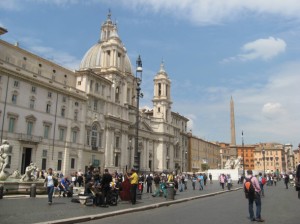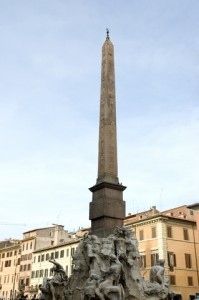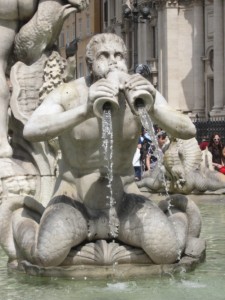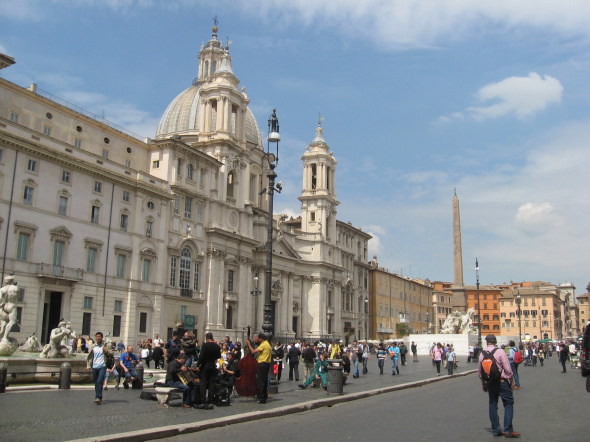 I must confess that I often pass by Piazza Navona and when I am in a hurry, I often take for granted this magnificent piazza which attracts tourists from all four corners of the world.
I must confess that I often pass by Piazza Navona and when I am in a hurry, I often take for granted this magnificent piazza which attracts tourists from all four corners of the world.
Occasionally, I would eat my packed lunch sitting on the bench in the Piazza while enjoying the surroundings and watching the excitement of the tourists as they first get a glimpse of the Piazza. Only then do I realize that I am fortunate to enjoy this beauty whenever I want.
Surprisingly, it was quiet this winter and a different scene altogether to see the Piazza Navona empty. However as it was colder than usual, I presume everyone thought it was better indoors.
As Spring is here, Piazza Navona is coming to life again. This morning, while walking towards Piazza Navona I thought about all the piazzas (the plural of piazza in Italian is actually piazze) in Rome and how the Romans must have loved socializing. It’s not a surprise then that the piazzas of Rome are truly gathering places for people who love the beauty of outdoor art in all its forms.
History of Piazza Navona
You may find it interesting to know that Piazza Navona was the site of the first century Stadium of Domitian which explains its long oval shape. With one end straight and the other end curved, it was designed for the original Olympic event of Greek-style foot races.
It was known as the Piazza in Agone which means the ‘Site of Competitions’ which eventually derived into the Piazza Navona. The original Stadium of Domitian would have held 30,000 spectators and was used for running events until the 5th century.
The Piazza has long been the site of many theatrical shows and horse races, fulfilling the demand of the Romans for entertainment of all sorts. From 1652 until 1866 the piazza was flooded every weekend in August for the celebrations and festivities enjoyed by the Pamphilj family.
Fountains of Piazza Navona
 Today, it features many sculptures and architectural creations by Gian Lorenzo Bernini. He designed the focal point of the Piazza in 1651, the Fontana dei Quattro Fiumi (Fountain of the Four Rivers) with its central Egyptian style obelisk. Arrayed around the central rocky mass supporting the almost-obligatory obelisk are four large sculptures executed by his students. One of them, the Ganges, was sculpted by Claude Poussin who would later become a master under his own name.
Today, it features many sculptures and architectural creations by Gian Lorenzo Bernini. He designed the focal point of the Piazza in 1651, the Fontana dei Quattro Fiumi (Fountain of the Four Rivers) with its central Egyptian style obelisk. Arrayed around the central rocky mass supporting the almost-obligatory obelisk are four large sculptures executed by his students. One of them, the Ganges, was sculpted by Claude Poussin who would later become a master under his own name.
The fountain is a masterpiece with a sea monster, a lion, cacti, palm tree and a dozen other pieces woven together around the central column. The funding was so large that taxes were levied on bread, prompting outcries from Roman citizens both poor and rich. But with the controversy now a part of history, you can simply relax and appreciate the beauty of it.
Two additional fountains are set out down the center of Piazza Navona. The Fontana di Nettuno (Fountain of Neptune) is at the north end and was sculpted by Giacomo Della Porta in 1574. Formerly known as Fontana dei Calderai (Fountain of the Coppersmiths), the Fountain of Neptune is surrounded with sea figures, Neptune slaying an octopus, sea horses, dolphins and Nerieds (sea nymphs). Another fact to point out it that the fountain is made of the same Portasanta rose marble used for vertical side frames of St. Peter’s door.
 At the south end, you will find the Fontana del Moro dating back to 1576 which features a Triton – one of the many gods of the sea – riding a dolphin. From this vantage point, there are benches around to just take a moment to relax, enjoy warm Roman sunshine and admire the Church of Sant’Agnese in Agone recognizable by its rolling concave façade.
At the south end, you will find the Fontana del Moro dating back to 1576 which features a Triton – one of the many gods of the sea – riding a dolphin. From this vantage point, there are benches around to just take a moment to relax, enjoy warm Roman sunshine and admire the Church of Sant’Agnese in Agone recognizable by its rolling concave façade.
Other points of interests
The church is dedicated to St Agnes who was martyred in the Stadium in 304AD. The baroque interior and massive sculpture depicting the Miracle of Sant’Agnese is quite stunning.
One other point of interest is the Palazzo Pamphilj, once home to Pope Innocent X with the papal insignia of Innocent X. It is now the Brazilian Embassy but it still has some beautiful frescoes by Pietro da Cortona which can be seen through the huge windows.
If you prefer strolling around, there are usually dozens of stalls, portrait painters, street performers interspersed among the many cafes and restaurants to keep you entertained.
Piazza Navona like many of the other piazzas in Rome is definitely a place where you see a variety of people from dog walkers to wide-eyed tour groups. At night, it’s also a popular place to hang out and residents often complain about the noise. However, Piazza Navona, is a popular attraction that will never fail to draw the crowds both day and night.
 BrowsingRome Blogging about my experiences and sharing my thoughts about Rome, Italy and beyond
BrowsingRome Blogging about my experiences and sharing my thoughts about Rome, Italy and beyond
